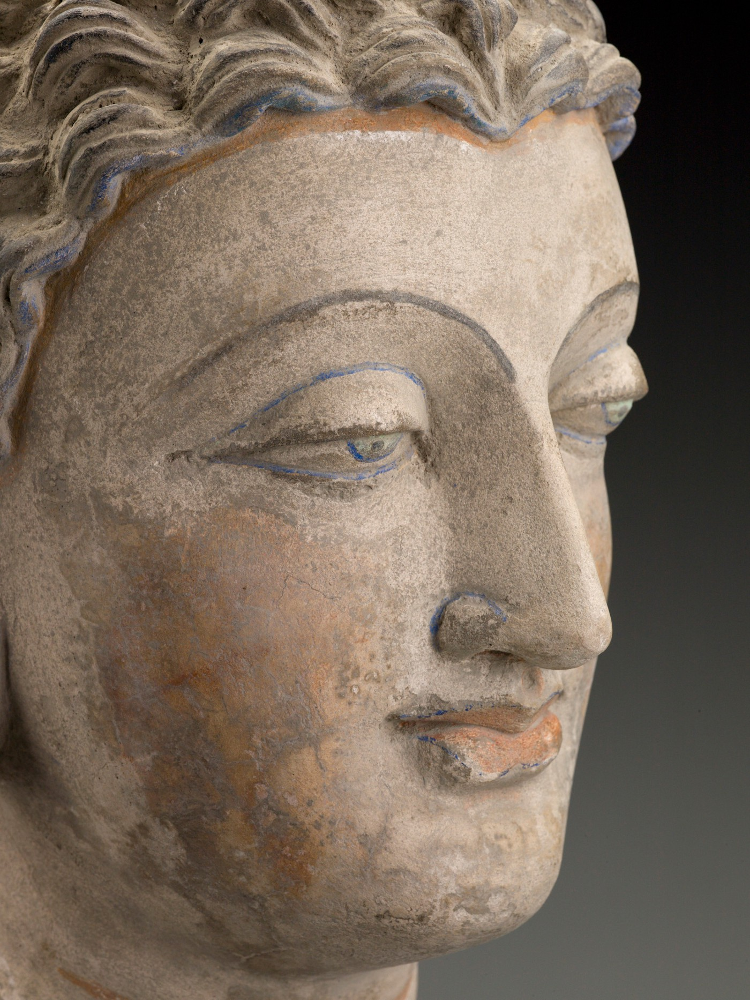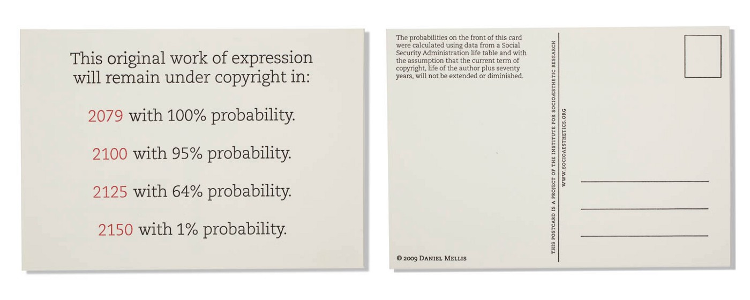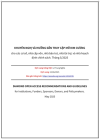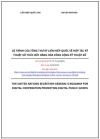


In her third post in a short series, Anne Young explores the practical details for doing some rights determinations. Read the first post here and the second one here.
Head of Buddha (detail), 200s–300s, stucco with paint, 15–3/4 x 7–3/4 x 7–1/4 in. Indianapolis Museum of Art at Newfields, Gift of the Alliance of the Indianapolis Museum of Art, 1994.1. Public Domain.
Do your homework first: do you know the copyright status of your collection objects?
GLAM institutions need to do some research before they make Public Domain content — or content in which they hold copyright — available via Open Access. Otherwise, what authority do they have to enact Open Access?
The challenges to R&R Specialists determining public domain with certainty are if a work has been published, registered, where was first published, if it was published with notice, and if registration was renewed. The older the work is, the harder it can be to answer these questions.
Firstly, you need to keep in mind the intellectual property and other issues discussed previously. Depending on the type of GLAM and the object(s) they steward, more than one IP type may apply. For simplicity today, I will address these general rules in terms of copyright, but the concepts can be applied to those other issues too.
Determining rights status is complicated. Here is an artist’s postcard intended to predict when this individual work will still be under copyright. The original expression of this postcard was registered with the U.S. Copyright Office with registration number VA0001672722. The Institute for Socioæsthetic Research, Private Domain Postcard. © 2009 Daniel Mellis.
Secondly, you might need to make broad determinations on a collection overall. Most R&R specialists don’t have the time or resources to research at the item level. General rules for making broad determinations include asking yourself the following questions:
When was the work published? Assume all works by the creator are unpublished or unregistered until research on individual works concludes otherwise, then calculate the term that applies in your country.
Who made the work? Works by anonymous creators or creators whose death date is unknown, and some other works, such as works made for hire, or in certain countries works made by corporations or institutions, might have a different term of protection that runs from the date of creation. For example, In the US, the first two types of works are under copyright for 120 years from the date of creation.
Was the work created by more than a single author? A single work may have multiple creators and therefore multiple copyrights, such as with underlying rights.
When did the author die? Works by living creators or creators who died in the past 70 years are under copyright for the life of the creator plus 70 years, if you are in a country that has life plus 70 years term. Check the term of your country here.
Are there any exceptions that apply? In some cases, you could publish the work on the GLAM’s website if limitations and exceptions apply, such as fair use in the US.¹
With all these in mind, plus the “other” considerations and the rules for broad determinations, we can start to consider how a GLAM can establish its R&R workflow: the bread and butter of processing requests to utilize collection content.
In our next post, we’ll analyze possible scenarios to institute a rights and reproductions policy and its impact on Open Access.
Disclaimer: The content of this post does not constitute legal advice nor does it refer to any particular or specific situation. If you have any doubts about your specific situation, you should consult with a lawyer.
These posts were compiled out of the set of tweets that Anne did during her curation of the @openglam Twitter account. Remember you can do it too, just sign up here!
Anne Young is the Director of Legal Affairs and Intellectual Property at Newfields and editor of “Rights and Reproductions: The Handbook for Cultural Institutions, Second Edition”, for which she received the Visual Resources Association’s Nancy DeLaurier Award in 2017.
[1] Megan P. Bryant, Cherie C. Chen, Kenneth D. Crews, John ffrench, Walter G. Lehmann, Naomi Leibowitz, Melissa Levine, Sofía Galarza Liu, Michelle Gallagher Roberts, Nancy Sims, Deborah Wythe and Anne M. Young, Rights and Reproductions: The Handbook for Cultural Institutions, Second Edition. Edited by Anne M. Young. Lanham, Maryland: Rowman and Littlefield, 2019, p. 65–66.
Some rights reserved CC BY-NC
Dịch: Lê Trung Nghĩa
Ý kiến bạn đọc
Những tin mới hơn
Những tin cũ hơn
Blog này được chuyển đổi từ http://blog.yahoo.com/letrungnghia trên Yahoo Blog sang sử dụng NukeViet sau khi Yahoo Blog đóng cửa tại Việt Nam ngày 17/01/2013.Kể từ ngày 07/02/2013, thông tin trên Blog được cập nhật tiếp tục trở lại với sự hỗ trợ kỹ thuật và đặt chỗ hosting của nhóm phát triển...
 Các tài liệu dịch sang tiếng Việt tới hết năm 2025
Các tài liệu dịch sang tiếng Việt tới hết năm 2025
 Loạt bài về AI và AI Nguồn Mở: Công cụ AI; Dự án AI Nguồn Mở; LLM Nguồn Mở; Kỹ thuật lời nhắc;
Loạt bài về AI và AI Nguồn Mở: Công cụ AI; Dự án AI Nguồn Mở; LLM Nguồn Mở; Kỹ thuật lời nhắc;
 Các bài trình chiếu trong năm 2024
Các bài trình chiếu trong năm 2024
 Tập huấn thực hành ‘Khai thác tài nguyên giáo dục mở’ cho giáo viên phổ thông, bao gồm cả giáo viên tiểu học và mầm non tới hết năm 2024
Tập huấn thực hành ‘Khai thác tài nguyên giáo dục mở’ cho giáo viên phổ thông, bao gồm cả giáo viên tiểu học và mầm non tới hết năm 2024
 Các lớp tập huấn thực hành ‘Khai thác tài nguyên giáo dục mở’ tới hết năm 2024
Các lớp tập huấn thực hành ‘Khai thác tài nguyên giáo dục mở’ tới hết năm 2024
 ‘Digcomp 2.2: Khung năng lực số cho công dân - với các ví dụ mới về kiến thức, kỹ năng và thái độ’, EC xuất bản năm 2022
‘Digcomp 2.2: Khung năng lực số cho công dân - với các ví dụ mới về kiến thức, kỹ năng và thái độ’, EC xuất bản năm 2022
 Tổng hợp các bài của Nhóm các Nhà cấp vốn Nghiên cứu Mở (ORFG) đã được dịch sang tiếng Việt
Tổng hợp các bài của Nhóm các Nhà cấp vốn Nghiên cứu Mở (ORFG) đã được dịch sang tiếng Việt
 Tổng hợp các bài của Liên minh S (cOAlition S) đã được dịch sang tiếng Việt
Tổng hợp các bài của Liên minh S (cOAlition S) đã được dịch sang tiếng Việt
 Năm Khoa học Mở & Chuyển đổi sang Khoa học Mở - Tổng hợp các bài liên quan
Năm Khoa học Mở & Chuyển đổi sang Khoa học Mở - Tổng hợp các bài liên quan
 Hội nghị Đối tác Dữ liệu Mở châu Á năm 2021 do Việt Nam lần đầu tiên chủ trì
Hội nghị Đối tác Dữ liệu Mở châu Á năm 2021 do Việt Nam lần đầu tiên chủ trì
 Khung năng lực AI cho giáo viên
Khung năng lực AI cho giáo viên
 Bạn cần biết những gì về các khung năng lực AI mới của UNESCO cho học sinh và giáo viên
Bạn cần biết những gì về các khung năng lực AI mới của UNESCO cho học sinh và giáo viên
 Bàn về 'Lợi thế của doanh nghiệp Việt là dữ liệu Việt, bài toán Việt' - bài phát biểu của Bộ trưởng Nguyễn Mạnh Hùng ngày 21/08/2025
Bàn về 'Lợi thế của doanh nghiệp Việt là dữ liệu Việt, bài toán Việt' - bài phát biểu của Bộ trưởng Nguyễn Mạnh Hùng ngày 21/08/2025
 Ngày Phần mềm Tự do, Ngày Phần cứng tự do, Ngày Tài liệu Tự do
Ngày Phần mềm Tự do, Ngày Phần cứng tự do, Ngày Tài liệu Tự do
 ‘Khung năng lực AI cho giáo viên’ - bản dịch sang tiếng Việt
‘Khung năng lực AI cho giáo viên’ - bản dịch sang tiếng Việt
 Các bài trình chiếu trong năm 2024
Các bài trình chiếu trong năm 2024
 Mark Zuckerberg: DeepSeek cho thấy vì sao nước Mỹ phải là ‘tiêu chuẩn nguồn mở toàn cầu’ của AI; không có lý do gì để suy nghĩ lại về việc chi tiêu
Mark Zuckerberg: DeepSeek cho thấy vì sao nước Mỹ phải là ‘tiêu chuẩn nguồn mở toàn cầu’ của AI; không có lý do gì để suy nghĩ lại về việc chi tiêu
 DeepSeek đã gây ra sự hoảng loạn trên thị trường — nhưng một số người cho rằng việc bán tháo là quá mức
DeepSeek đã gây ra sự hoảng loạn trên thị trường — nhưng một số người cho rằng việc bán tháo là quá mức
 ‘KHUYẾN NGHỊ VÀ HƯỚNG DẪN TRUY CẬP MỞ KIM CƯƠNG cho các cơ sở, nhà cấp vốn, nhà bảo trợ, nhà tài trợ, và nhà hoạch định chính sách’ - bản dịch sang tiếng Việt
‘KHUYẾN NGHỊ VÀ HƯỚNG DẪN TRUY CẬP MỞ KIM CƯƠNG cho các cơ sở, nhà cấp vốn, nhà bảo trợ, nhà tài trợ, và nhà hoạch định chính sách’ - bản dịch sang tiếng Việt
 Nhà khoa học AI hàng đầu của Meta cho biết thành công của DeepSeek cho thấy 'các mô hình nguồn mở đang vượt trội hơn các mô hình độc quyền'
Nhà khoa học AI hàng đầu của Meta cho biết thành công của DeepSeek cho thấy 'các mô hình nguồn mở đang vượt trội hơn các mô hình độc quyền'
 50 công cụ AI tốt nhất cho năm 2025 (Đã thử và kiểm nghiệm)
50 công cụ AI tốt nhất cho năm 2025 (Đã thử và kiểm nghiệm)
 “Chúng tôi không có hào nước”: Sự đổi mới đột phá của AI nguồn mở
“Chúng tôi không có hào nước”: Sự đổi mới đột phá của AI nguồn mở
 UNESCO dành Ngày Giáo dục Quốc tế 2025 cho Trí tuệ nhân tạo
UNESCO dành Ngày Giáo dục Quốc tế 2025 cho Trí tuệ nhân tạo
 ‘Đặc tả Khung Tính mở Mô hình (MOF)’ của LF AI & Data - Tài sản chung của AI Tạo sinh - bản dịch sang tiếng Việt
‘Đặc tả Khung Tính mở Mô hình (MOF)’ của LF AI & Data - Tài sản chung của AI Tạo sinh - bản dịch sang tiếng Việt
 ‘LỘ TRÌNH CỦA TỔNG THƯ KÝ LIÊN HIỆP QUỐC VỀ HỢP TÁC KỸ THUẬT SỐ THÚC ĐẨY HÀNG HÓA CÔNG CỘNG KỸ THUẬT SỐ’ - bản dịch sang tiếng Việt
‘LỘ TRÌNH CỦA TỔNG THƯ KÝ LIÊN HIỆP QUỐC VỀ HỢP TÁC KỸ THUẬT SỐ THÚC ĐẨY HÀNG HÓA CÔNG CỘNG KỸ THUẬT SỐ’ - bản dịch sang tiếng Việt
 Dữ liệu để phân loại AI
Dữ liệu để phân loại AI
 AI trong TVET - Một vài gợi ý triển khai trong thực tế
AI trong TVET - Một vài gợi ý triển khai trong thực tế
 Tài sản chung kỹ thuật số và Hàng hóa Công cộng Kỹ thuật số - Tìm thấy nền tảng chung cho các nhà hoạch định chính sách
Tài sản chung kỹ thuật số và Hàng hóa Công cộng Kỹ thuật số - Tìm thấy nền tảng chung cho các nhà hoạch định chính sách
 Khung năng lực AI cho học sinh
Khung năng lực AI cho học sinh
 ODI và Solid cùng nhau trao cho các cá nhân quyền kiểm soát lớn hơn đối với dữ liệu cá nhân
ODI và Solid cùng nhau trao cho các cá nhân quyền kiểm soát lớn hơn đối với dữ liệu cá nhân